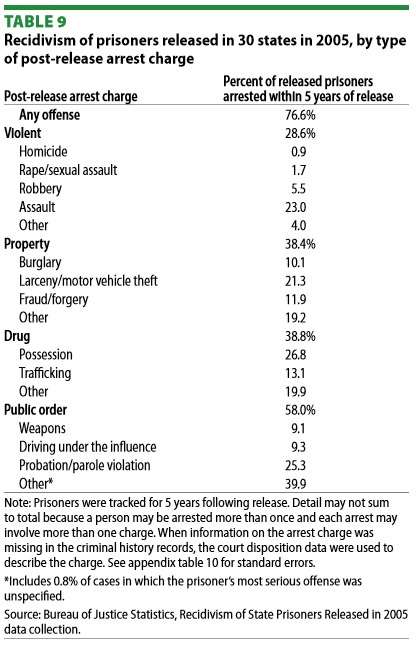Of Course Recidivism Is High When Everything Is a Crime


A new report released this week from the Bureau of Justice Statistics indicates that slightly more than three-quarters of released prisoners will end up arrested again within five years.
The report has not gotten a whole lot of attention, though Caitlin Dickson delves into the stats over at The Daily Beast and tries to draw out some meaning. After noting that rearrest doesn't mean these people end up back in prison (that number is much more modest, less than 30 percent), she spoke with some college experts:
CUNY's John Jay College of Criminal Justice Professor Deborah Koetzle … hopes that the drastic numbers will spark more conversation about the need for rehabilitation and re-entry programs to combat recidivism.
"In a lot of ways we set people up because we put them in prisons, which are are coercive, violent environments that can have psychological impacts, and when they come out we put up a lot of barriers," Koetzle told The Daily Beast. "We make it difficult for them to get jobs, to find housing. We put them back in an environment where there's a lot of temptations without a lot of support."
Koetzle argues that most correctional facilities are not equipped with the types of psychological or substance abuse treatment programs many inmates need, making it unsurprising when people come home and get into trouble again.
"We spend a lot of money incarcerating people and it's not a very efficient way of doing things unless we're providing treatment," Koetzle said. "We should to look at these figures and think, there is a reason for this. We need to do a better job."

Having lived in and run a newspaper in a small town for a decade and having watched regular "probation sweeps" from law enforcement agencies looking for any reason to drag ex-offenders back to jail, I immediately wondered exactly what kinds of crimes were getting these people rearrested. I thumbed through the full 31-page report (pdf) and found what I was looking further in. Fully a quarter of rearrests included probation or parole violations. More than 38 percent were rearrested for drug-related violations. The chart on the right shows the distribution of charges for recidivists.
Because arrests may involve several different charges, the totals add up to more than 100 percent and we can't really determine the number of people arrested for "public order" or probation violations who were also charged with violent or property crimes from the chart. We can see, though, that the majority of rearrests involve these public order violations, the greatest percentage falling under the "other" category. The report classifies these crimes as "those that violate the peace or order of the community or threaten the public health or safety through unacceptable conduct, interference with governmental authority, or the violation of civil rights or liberties. The category also includes probation or parole violation, escape, obstruction of justice, court offenses, nonviolent sex offenses, commercialized vice, family offenses, liquor law violations, bribery, invasion of privacy, disorderly conduct, contributing to the delinquency of a minor, and other miscellaneous and unspecified categories."
What does it say about our criminal justice system when only 28 percent of our repeat criminals are committing violent crimes, only 38 percent are committing property crimes, but 40 percent of them are falling in this catch-all category of "other" crimes that are so extensive that even a report full of statistics for recidivism isn't able to account for them all?
Show Comments (13)